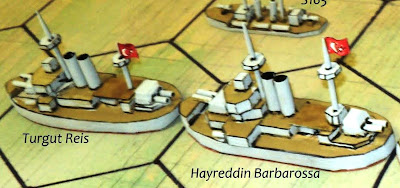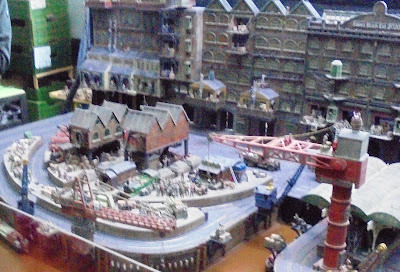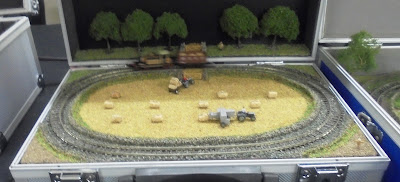Wishing all my friends and fellow bloggers a Merry Christmas!
Wednesday, 25 December 2024
Tuesday, 24 December 2024
A break for rest and recuperation
I have decided to take a break from blogging over the Christmas period, but I will return once the holiday is over and 2025 has begun.
The last twelve months have been very mentally and physically draining, and both Sue and I need to enjoy some rest and recuperation. Christmas is an ideal time to do this, and we intend spending some quality time together relaxing, sleeping, reading, watching films, and probably eating and drinking too much!
Sunday, 22 December 2024
The Brandenberg-class predreadnoughts: Some models
As regular blog readers will already know, I own two 1:1200th-scale models of Brandenberg-class battleships.
As part of his First Blacklands War project, Archduke Piccolo built models of the Hayreddin Barbarossa and Turgut Reis. As can be seen from the following photographs, he captured the look of the design whilst still producing some excellent wargame models of the ships.
Archduke Piccolo's unpainted model of the Hayreddin Barbarossa.
Archduke Piccolo's unpainted model of the Turgut Reis.
Archduke Piccolo's completed models of the Turgut Reis (left) and the Hayreddin Barbarossa (right).
Please note that the last three photographs shown above are © Archduke Piccolo.
Friday, 20 December 2024
The Brandenberg-class predreadnoughts
The four ships of the Brandenberg-class were the first heavy armoured ocean-going ships built for the Imperial German Navy. Unlike the previous classes, they were not intended to perform a coastal defence role. The layout of their main armament – three fully shielded twin-gunned barbettes (one forward, one in the centre, and one aft, and all on the ship’s centreline) – also predated the similar layout adopted by some of the early dreadnought battleships.
A side and plan view of the Brandenberg-class battleships showing the arrangement of her armament.
A side and plan view of the Brandenberg-class battleships showing the arrangement of their armour.
The four ships in the Brandenberg-class were:
- SMS Brandenburg
- SMS Wörth
- SMS Weissenburg
- SMS Kurfürst Friedrich Wilhelm
SMS Brandenberg.
SMS Wörth.
SMS Weisenburg.
SMS Kurfürst Friedrich Wilhelm.
The class's characteristics were:
- Displacement: 10,500 ton (Full load)
- Dimensions:
- Length: 115.7m (379ft 7in)
- Beam: 19.5m (64ft)
- Draught: 7.9m (25ft 11in)
- Propulsion: 12 x transverse Scotch marine boilers providing steam to 2 x triple-expansion steam engines (9,900ihp) each powering a propeller
- Speed: 16.5 knots
- Range: 4,500 nautical miles at 10 knots
- Complement: 568 (38 officers and 530 men
- Armament: 2 x 2 28cm (11-inch) MRK L/40 guns: 2 x 28cm MRK L/35 guns; 6 x 10.5cm (4.1-inch) SK L/35 quick-firing guns; 8 × 8.8cm (3.5-inch) SK L/30 QF guns; 6 × 45cm (17.7inch) torpedo tubes
- Armour:
- Belt: 300 to 400mm (11.8 to 15.7-inch)
- Barbettes: 300mm (11.8-inch)
- Deck: 60mm (2.4-inch)
- Conning tower: 300mm (11.8-inch)
The ships were originally designed to have a uniform main armament of six 28cm (11-inch) MRK L/35 guns, but by the time they were being constructed, the newer MKM L/40 became available. It was possible to fit these in the fore and aft barbettes but they were too long for the central one. As a result, the fore and aft guns had a maximum range of 15km (9.3 nautical miles) and effective range of 11km (6.8 nautical miles) whereas those in the central barbette had a maximum range of 14.45km (8.98 nautical miles) and an effective range of 11km (6.8 nautical miles).
It is interesting to note that the 28cm (11-inch) MRK L/35 cannon was supplied to Norway and used to arm the Oscarborg Fortress on Oslofjord. The fortress formed part of the defences of Oslo and sank the German heavy cruiser Blücher during the Battle of Drøbak Sound on 9th April 1940, thus delaying the capture of the Norwegian capital and allowing the Royal family time to escape.
One of the 28cm (11-inch) MRK L/35 guns at the Oscarborg Fortress.
The first two ship completed were fitted with compound side armour but the last pair had Krupp's nickel steel armour. This had better resistance to penetration by shells, and in his wargame rules – which were based on available contemporary data – Fred Jane stated that 8-inches of nickel steel armour was equal in effectiveness to 11-inches of compound armour.
When they entered service in 1893, they formed the 1st Squadron, with Kurfürst Friedrich Wilhelm acting as the squadron's flagship. After the Boxer Rising in 1900, the squadron was sent to China to support operations being carried out by the allied nations, but the fighting was almost over by the time they arrived. On their return to Germany in 1902, they were modernised.
In 1910 Kurfürst Friedrich Wilhelm and Weissenburg were sold to Turkey and renamed Hayreddin Barbarossa and Turgut Reis. They rapidly deteriorated due to poor crew training and maintenance and took no active part in the Italo-Turkish War in 1911.
Hayreddin Barbarossa.
Turgut Reis.
The First Balkan War broke out soon after the end of the Italo-Turkish War and both ships formed part of the armoured squadron sent to confront the Greek Fleet. The two fleets clashed near the mouth of the Dardanelles (the action was known as the Battle of Elli or the Battle of the Dardanelles) and both suffered damage. The Turkish fleet then withdrew from the Aegean and this enabled the Greeks to occupy the islands of Lesbos, Chios, Lemnos and Samos.
Although Turkey initially remained neutral when the First World War broke out, the Ottomans sided with the Central Powers in November 1914. As they were still in a poor condition, the Hayreddin Barbarossa and Turgut Reis were partially disarmed and their secondary armament guns were used to bolster the defences of the Dardanelles. They did – however – retain their main armament so that they could act as floating batteries.
One of the pair was usually deployed in the Dardanelles to support the coastal defences situated there whilst the other was withdrawn so that it could undergo maintenance and resupply. On 8th August 1915 the Hayreddin Barbarossa was moving forward to fire at the Allied troops who were occupying parts of Gallipoi when she was torpedoed by the British submarine E11 off Bulair near the northern entrance of the Dardanelles. The ship rapidly sank and 21 officers and 237 men were lost. As a result, the Turgut Reis was kept well away from any offensive action until the end of the war.
Turgut Reis was decommissioned at the end of the war. She was refitted in 1924-1925 so that she could be used as a training ship. She perfromed this role unti 1933, when she was decommissioned for the final time and became a floating barracks. Turgut Reis was fianlly broke up between 1950 and 12957.
The remaining ships – the SMS Brandenberg and SMS Wörth – remained in service with the Imperial German Navy until 1912. They were recommissioned after the outbreak of the Great War to form part of 5th Squadron which had been created to defend the North Sea coastline of Germany. In September 1914 they and the rest of 5th Squadron were redeployed to the Baltic to support a planned landing at Windau in northwest Latvia by German forces, but when this didn't take place, they were decommissioned. They were recommissioned in early 1915 to guard the newly captured port of Libau in western Latvia. They were finally decommissioned and disarmed in 1916 and thereafter used as barrack ships before being sold for scrap in 1919.
Thursday, 19 December 2024
HMS Unicorn: The forerunner of the Light Fleet Aircraft Carrier?
In a recent comment to Part 2 of my recent blog posts about the 1942 Light Fleet Aircraft Carriers, Martin Rapier mentioned the apparent 'luxury' enjoyed by the Royal Navy of being able to have a maintenance carrier. In reply, I mentioned that the Royal Navy had actually designed and built a maintenance carrier before the 1942 Light Fleet Aircraft Carriers were designed, and that this ship was HMS Unicorn.
As a result of the Abyssinian Crisis in 1935, the Royal Navy realised that it needed to have some sort of depot ship for the aircraft carried aboard its ships in the same way that they had depot ships for destroyers, submarines, and smaller craft. HMS Unicorn was designed to meet this requirement, and because she was classified as a depot ship, she did not count towards the UK's aircraft carrier tonnage limit set by the London Naval Treaty.
From a distance, the design resembled a shorter version of the Illustrious-class armoured aircraft carriers, but she was armed more like the destroyer and submarine depot ships (e.g. HMS Woolwich and HMS Forth).
The ship's characteristics were as follows:
- Displacement:20,300 tons (deep load)
- Dimensions:
- Length: 640ft (195.1m)
- Beam: 90ft 3in (27.51m)
- Draught: 23ft (7.0m)
- Propulsion:4 x Admiralty 3-drum boilers providing steam to 2 x geared steam turbine (40,000shp), each driving a propeller
- Speed: 24 knots
- Range: 7,000 nautical miles at 13.5 knots
- Complement: 1,200 (wartime)
- Radar: 1 x Type 281B Early-warning radar; 2 x Type 285 gunnery radars
- Armament: 4 × twin 4-inch (102 mm) dual purpose guns; 4 × quadruple Mk. VIII 2-pounder (40 mm (1.6-inch)) anti-aircraft guns; 2 × twin and 8 × single 20mm (0.8-inch) Oerlikon anti-aircraft guns
- Armour:
- Flight deck: 2-inch (51mm)
- Magazines: 2 to 3-inch (51 to 76mm)
- Bulkheads: 1.5-inch (38mm)
- Aircraft carried: Approximately 33 (when used operationally)
HMS Unicorn was ordered on 14th April 1939, laid down at Harland & Wolf, Belfast on 26th June 1939, launched on 20th November 1941, and completed on 12th June 1943. Her completion was delayed in order that work on more urgently needed ships could be prioritised.
Due to the pressing need to get as many aircraft carriers as possible into service, HMS Unicorn was not fitted out for her original role. She escorted a number of convoys between Gibraltar and the Clyde before being attached to the flotilla providing air cover for the Allied landings at Salerno.
On her return to the UK in September of that year, she was refitted for her original role. In December 1943 HMS Unicorn was sent to the Far East to reinforce the Eastern Fleet. She remained there until the end of the war. HMS Unicorn returned to the UK in January 1946 and was decommissioned soon afterwards.
HMS Unicorn was recommissioned in 1949 to support Royal Naval operations in the Far East. As a result, she was available to support UN operation in Korea and actually conducted a bombardment of North Korean positions using her 4-inch guns.
In 1952 consideration was given to rebuilding her so that she could operate the newer, heavier aircraft that were coming into service. This would have required her being fitted with a steam catapult, the reinforcement and strengthening of her flight deck, moving and enlarging her forward aircraft lift, and fitting a newer aircraft-handling crane capable of lifting heavier aircraft. The refit was planned to take place in mid 1954, but it was cancelled so that the limited funds available could be used to refit other aircraft carriers with angled flight decks. Instead, HMS Unicorn was reclassified as a ferry carrier and placed in reserve in March 1957. She was sold for scrapping in June 1959.
Although the 1942 Light Fleet Aircraft Carriers were of a similar size and function to HMS Unicorn, there is no evidence that the design of the former was based in any way on that of the latter. HMS Unicorn was built by Harland & Wolf whereas the detailed design of the 1942 Light Fleet Aircraft Carriers was carried out by Vickers-Armstrong.
Wednesday, 18 December 2024
HMCS Protector
In a comment on my recent blog post, Kev Robertson indicated that he was thinking of building a model gunboat to use with his newly-acquired 15mm Essex Miniatures sailor figures. In reply, I suggested that he ought to think about building a model of HMCS* (later HMAS) Protector.
Protector was an unusual ship in that she was designed and built for the Government of South Australia and combined elements of the Elswick flatiron gunboats and the small colonial cruisers/gunboats operated by the Royal Navy. She was designed and built by Armstrong, Mitchel & Co (the owners of the Elswick shipyard) and cost £65,000.
Laid down on 16th November 1882, she was launched in May 1884, and commissioned on 19th June 1884. Protector sailed for Australia on 27th June 1884 and went via the Mediterranean and the Suez Canal to Columbo (in Sri Lanka) before sailing on to Port Adelaide. She arrived there on 30th September 1884.
HMCS Protector as built.
Her characteristics were:
- Displacement: 921 tons
- Dimensions:
- Length: 185ft (54,9m)
- Beam: 30ft (17.1m)
- Draught: 12ft 6in (3.7m)
- Propulsion: 2 horizonal compound surface condensing steam engines, each driving a propeller shaft
- Speed: 14 knots
- Complement: 90
- Armament:
- 1884: 1 x 8-inch Mk.VII breech-loading gun; 5 x 6-inch breech-loading guns; 4 x 3-pounder quick-firing guns; 5 x 10-barrelled Gatling machine guns (She also carried 200 x 0.45-inch Martini-Henry Mk.IV rifles, 100 x breech-loading revolvers, 100 x cutlasses, and 30 x boarding pikes so that her crew could serve ashore as part of a naval brigade)
- 1912: 3 x 4-inch Mk.III quick-firing guns; 2 x 12-pounder quick-firing guns; 4 x 3-pounder quick-firing guns
From 1884 until 1899, Protector spent most of her service in South Australian waters or undertaking training exercises in Largs Bay. When the Boxer Rebsllion broke out in 1900, she was offered for service in China, and this offer was accepted although for legal reasons she had to be temporarily commissioned into the Royal Navy and a Royal Navy officer appointed to act as her captain. She arrived in Hong Kong on 11th September 1900 and remained in Chinese waters until early November 1901. During her service there, Protector acted as a despatch and survey vessel.
Protector was transferred from South Australian service to the Royal Australian Navy when the RAN was formed in 1911 and she was subsequently rebuilt in 1912 and used as a gunboat.
HMAS Protector after her conversion into a gunboat.
At the beginning of World War I she acted as tender for the two Australian submarines AE1 and AE2 at Port Jackson. She also took part in the capture of Samoa from the Germans and then spent most of the rest of the war on patrol in Australian waters.
Once the war was over, HMAS Protector served as the tender to HMAS Cerberus. In April 1921 she was renamed Cerberus when the existing Cerberus was renamed Platypus II. She was sold in 1924 for conversion into a merchant vessel. As a result, all her armament, removable equipment, boilers and engines were removed and she became an unpowered lighter.
In 1932 her hulk was renamed Sydney and she was used as a wool lighter by the Victorian Lighterage Company. She was requisitioned by the US Army in 1943, but whilst under tow to New Guinea she was damaged in a collision with a tug. She was then sold and beached off Heron Island, Queensland for use as a breakwater. Her remains still exist today, albeit in a deteriorated state.
* HMCS stood for Her/His Majesty's Colonial Ship. When the Royal Australian Navy was formed, this was changed to HMAS.
Tuesday, 17 December 2024
The 1942 Light Fleet Aircraft Carrier: Part 3: The Majestic-class
The second batch of Light Fleet Aircraft Carriers were completed to a modified design and were therefore classified as a separate class, the Majestic-class.
The main differences in their design from that of the earlier Colossus-class were:
- The catapult, arrester gear, and lifts were upgraded to enable the ships to operate heavier aircraft.
- The flight deck was reinforced to enable the ships to operate heavier aircraft.
- Improved armament and radar equipment were fitted.
- Equipment to allow replenishment at sea was fitted.
These changes increased the design's full load tonnage by 1,500 tons and the draught by 1 foot 6 inches.
When they were ordered, they were allocated the following names:
- HMS Majestic
- HMS Terrible
- HMS Magnificent
- HMS Hercules
- HMS Leviathan
- HMS Powerful
When the Second World War ended, none of the ships were complete and construction was suspended. Five were eventually completed between 1948 and 1961 to modified designs, but one - HMS Leviathan - was scrapped incomplete in 1968 although her boilers were used to repair HMNLS Karel Doorman.
HMS Majestic/HMAS Melbourne
HMAS Melbourne.
She was sold to Australia in an incomplete state in 1947 and completed to a modified design. This included an 5.5-degree angled flight deck, a steam catapult, a reinforced flight deck and lifts, strengthened anrrester gear, and a mirror landing aid. She was also fitted with an enhanced armament that comprised 6 x twin and 13 x single 40mm Bofors anti-aircraft guns. She was commissioned on 26th October 1955 as HMAS Majestic and renamed HMAS Melbourne two days later. She was refitted between late 1967 and early 1969 to enable her to operated modern aircraft, and this included further strengthening of the flight deck and arrester gear, improvements to the steam catapult and aviation fuel supply system, and an upgraded radar suite. A further refit in 1971 saw her steam catapult rebuilt and her air conditioning system improved. More work on her steam catapult took place during a refit that lasted from late 1972 until the middle of 1973, and she was again refitted from April 1975 until June 1976 to extend her operational life until 1985. Another refit took place from late 1978 until the middle of 1979, but a further refit planned for 1981 was cancelled and she was placed in reserve in 1982. She was sold to China for scrapping in 1985 but this was not completed until 2002.
HMS Terrible/HMAS Sydney
HMAS Sydney.
She was sold to Australia in an incomplete state in 1947 and completed and commissioned into the Royal Australian Navy in 1948. She supported United Nations operations in Korea from late 1951 to early 1952. When her more modern sister ship (HMS Melbourne) was commissioned in 1955, she became a training ship. She performed this role until she was decommissioned in 1958. She was recommissioned as a fast troop transport in 1962 to support Australian troops operating in Vietnam, having been converted from 1961 to 1962. During her conversion, her aircraft operating equipment was removed, the hangar was converted into troop accommodation and vehicle storage, and her armament was reduced from 19 to 4 single-mounted 40 mm Bofors anti-aircraft guns. In July 1973 she was withdrawn from service and in October 1975 she was sold for scrapping.
HMS Magnificent/HMCS Magnificent
HMCS Magnificent.
She was loaned to the Royal Canadian Navy whilst still incomplete and commissioned into the RCN on 21st March 1948. She spent most of her service operating in the North Atlantic and Caribbean although she did transport Canadian peacekeepers to Egypt in 1957. When HMCS Bonaventure was commissioned in 1957 she was returned to the UK. She never re-entered service and was placed on the disposal list in 1961 and scrapped in 1965.
HMS Hercules/INS Vikrant
INS Vikrant.
Sold incomplete to the Indian Navy in 1957 and completed with an angled deck, steam catapults, and a modified island. Her original armament comprised 16 x 40mm Bofors anti-aircraft guns but this was later reduced to 8 x 40mm Bofors anti-aircraft guns During her service she took part in Operation Vijay (the operation to occupy Goa) and the 1971 Indo-Pakistan War. She was modernised in 1979 to 1981 and again in 1987 to 1989. During the latter modernisation she was equipped with a 9.75-degree ski jump ramp in place of her steam catapult so that she could operate Sea Harriers. She was refitted in 1991 and again in 1992 to 1994 to extend her operational life, but in early 1995 she was withdrawn from active service. She was finally decommissioned in January 1997 and it was planned to use her as a museum ship in Mumbai. She was open to the public from 2001 to 2012, at which point it was decided that unless considerable remedial work was undertaken, she would be too unsafe to remain open. The funding was not forthcoming and she was sold for scrapping in January 2014.
HMS Powerful/HMCS Bonaventure
HMCS Bonaventure.
Sold incomplete to the Royal Canadian Navy in 1952. She was the completed to a modified design which included a new armament (4 x twin 3-inch (76mm)/50 guns; 8 x 40mm Bofors anti-aircraft guns), a remodelled island with a lattice mast and raked funnel, an American radar suite, a strengthened flight deck, an angled flight deck, steam catapults, and an optical landing system. She was commissioned on 17th January 1957, initially with a mixed air group. When her McDonnell Banshee fighters were retired, she took on an anti-submarine warfare role. She was refitted in 1966 and 1967 to extend her operational life, but budget cuts led to her to be decommissioned in July 1970 and sold for scrapping in 1971. Some parts of her steam catapult were cannibalised before she was sold and used to repair HMAS Melbourne.
Monday, 16 December 2024
Woolwich Model Railway Show
The Woolwich Model Railway Show took place at the nearby Shrewsbury House on Sunday 15th December. It was organised by Dawn Quest (a journalist and TV producer), who has a YouTube channel and website devoted to railway modelling.
Sue and I were very lucky in that I was able to park in one of the three onsite disabled parking bays, which meant that we were almost right outside the front door. It cost a total of £7.00 to get in as we are over 60-years-old and I am disabled.
The following photographs give some idea of the range of layouts that were on display, including two built by Dawn Quest.
This impressive layout used almost entirely 3D printed buildings, rolling stock, vehicles etc.
This simple oval and siding layout depicted a British First World War casualty clearing station and hospital.
The LadyKillers (00)
This is Dawn Quest's second and newest exhibition layout. It is based on the location of the 1955 film of that name.
Gamma Silo Rotatory (On30/O)
Brief Encounter (00)
This was Dawn Quest's first exhibition layout. It is in monochrome ... just as the original 1945 film was.
Hengist Road (00)
Little Narrow (00)
Asham Cement Works (009)
Staffordshire Potteries (N)
The exhibitor also had a small, circular, festive layout on show.
Four Feather Falls (Triple O)
I always wanted a Lone Star Treble O Electric train set when I was a young teenager ... but it was not to be.
Tsurlito Japanese layout in a fish tank (HO)
This layout gave the impression that the train was actually going though the water!
Round Trees OO
The exhibitor also had a small additional layout ('The Lady Killed Her') on show.
Volkes Vest HOe
Thomas Tank Engine & Friends (1)
These models were featured in the original 'Thomas the Tank Engine' TV series.
D-Ikea Kato diorama (N)
These wonderful modules were all created on IKEA cork mats.
There were also a number of 'model railways in a case' layouts on show.
Due to to light conditions in the venue and the crowds (I was jostled a lot, particularly by small children who were anxious to see the exhibits), the quality of some of the photographs are not as good as I would have hoped.





























































































.jpeg)















